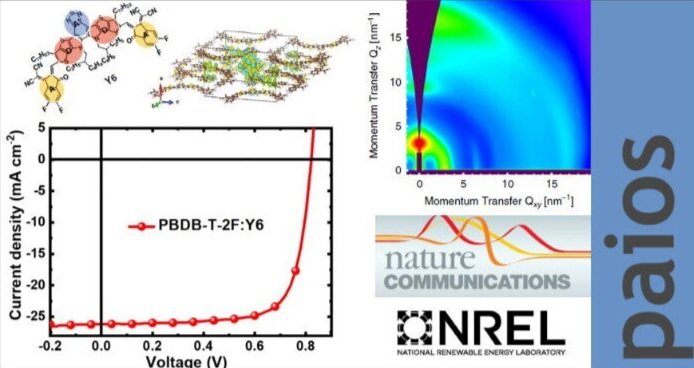Latest Solar Cell and LED Research
/Research is the backbone of what we do at Fluxim and we're always super proud to see researchers publishing high impact work using our tools. Here are some of the highlights of the last few months:
Perovskite Solar Cell Research
Space-charge-limited electron and hole currents in hybrid organic-inorganic perovskites
Mohammad Alvar, Paul W. M. Blom & Gert-Jan A. H. Wetzelaer
ACS Appl. Mater. Interfaces 2020, 12, 21, 23874
https://www.nature.com/articles/s41467-020-17868-0
This paper details the advancements in understanding the physics of charge transport in perovskite photovoltaics.
Extracting the mobility of the charge carriers in a perovskite solar cell is not straightforward. Several techniques have been used, but the interpretation of the results is difficult due to the presence of both ions and electrons/holes. Theories that have been developed for less complex systems are used also for perovskites without considering that ions affect the distribution of the electric field which, in most cases, makes the assumptions of the theory invalid.
This is the case of the frequently used Space Charge Limited Current (SCLC) method.
Researchers at the Max Planck Institute for Polymer Research developed a rigorous framework to extract the charge mobility from the SCLC-JV characteristics of pero-PVs. This work demonstrates also how to combine experiments and simulations to gain reliable insights into the transport mechanisms in a perovskite. The researchers used our characterization tool Paios to perform scan-dependent electrical characterizations on their devices at different temperatures.
Would you like to learn how Paios was used in this research?
Perovskite LED Research
Ultrathin PEDOT:PSS Enables Colorful and Efficient Perovskite Light‐Emitting Diodes
J. Lu, W. Feng, G. Mei, J. Sun, C. Yan, D. Zhang, K. Lin, D. Wu, K. Wang, and Z. Wei
https://onlinelibrary.wiley.com/doi/epdf/10.1002/advs.202000689
Adv. Sci. 2020, 7, 2000689
The External Quantum Efficiency (EQE) of Perovskite Light-Emitting Diodes (PeLEDs) is increasing fast.
External Quantum Efficiency (EQE) of green, red, and near-infrared PeLEDs reached already 20%. Blue PeLEDs are exceeding an EQE of 10%.
As shown by Prof. Wang and colleagues, even by simply optimizing the properties of the well-known PEDOT: PSS transport layer, it is possible to increase the efficiency of a pero-LED by around 80% with respect to the control device.
The researchers used the simulation software Setfos to predict how to fabricate a device with improved carrier mobility, suitable energy level alignment, and reduced photon losses. The simulation software setfos can show how to improve a pero-LEDs before even starting the actual experiment. Based on the results from the simulation, the fabrication is not only driven by preliminary guesses, but by a powerful prediction of the device behaviour based on comprehensive physical modelling.
Read this paper and more LED research
Do you want to learn how simulation can speed up your research?
Organic Solar Cell Research
Efficient Double- and Triple-Junction Nonfullerene Organic Photovoltaics and Design Guidelines for Optimal Cell Performance
Yuliar Firdaus, Carr Hoi Yi Ho, Yuanbao Lin, Emre Yengel, Vincent M. Le Corre, Mohamad I. Nugraha, Emre Yarali, Franky So, and Thomas D. Anthopoulos
https://pubs.acs.org/doi/10.1021/acsenergylett.0c02077
ACS Energy Lett. 2020, 5, 12, 3692–370
Researchers at the KAUST Solar Center (KSC) are giving guidelines to design an optimal Organic Solar Cell (OSC).
They are focusing on non-fullerene multijunction solar cells that, despite the broader light absorption, are still suffering from low Power Conversion Efficiency (PCE).
Before the device fabrication, the team of Prof. Thomas Anthopoulos and collaborators used Setfos to understand what are the main factors that limit the efficiency of a multijunction solar cell.
They understood that, aside from the clear requirement of matching the absorption spectra of the different materials, having low bimolecular recombination and high mobility on the front-cell was the key. Based on the knowledge given by the simulation, they fabricated multijunction organic solar cells which are among the highest efficient devices reported to date. On double-junction OPVs they achieved a conversion efficiency of 16.5%.
Read this paper and more OPV research
Do you want to learn more about Setfos?
Delocalization of exciton and electron wavefunction in non-fullerene acceptor molecules enables efficient organic solar cells
G. Zhang, V. Coropceanu, C.J. Brabec, J.-L. Bredas, H.-L. Yip & Y. Cao
https://www.nature.com/articles/s41467-020-17867-1
Nature Communications 11, 3943 (2020)
Organic Solar Cells (OSCs) with a power conversion efficiency (PCE) of 15.6% have been certified by the National Renewable Energy Laboratory (NREL).
An international collaboration led by the University of Arizona demonstrated that, by using the innovative non-fullerene acceptor Y6, is possible to obtain OSCs with a PCE as high as 16.5%. Almost all components were processed via solution methods.
The researchers showed that Y6 molecules have a favorable π-π molecular packing not only in the single crystal but also in the spin-coated film. By combining experiments and simulations, they proved that the high PCE in these OSCs is given by the delocalized nature of the electron wavefunctions in the Y6 stack, which makes this an efficient ambipolar material. When blending the Y6 with a polymer donor, they observed a high charge generation efficiency at the donor/acceptor interface.
The OSCs have been also characterized by different electro-optical methods. The Transient Photocurrent (TPC) and Transient Photovoltage (TPV) experiments were performed with Paios.
Read this paper and more solar cell research






